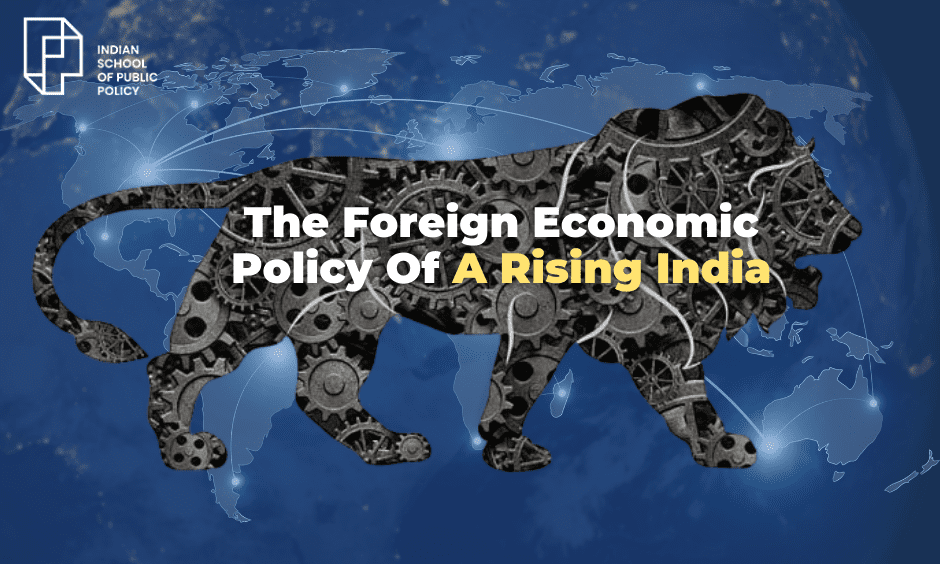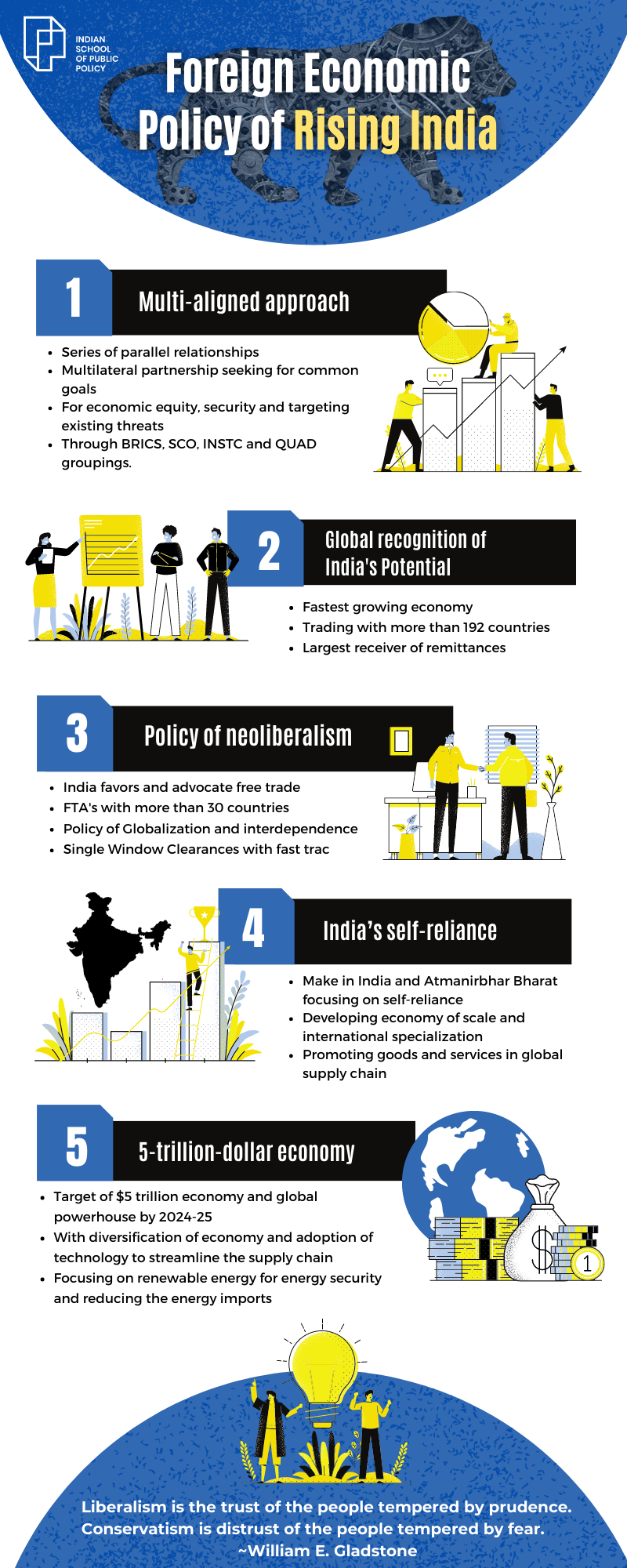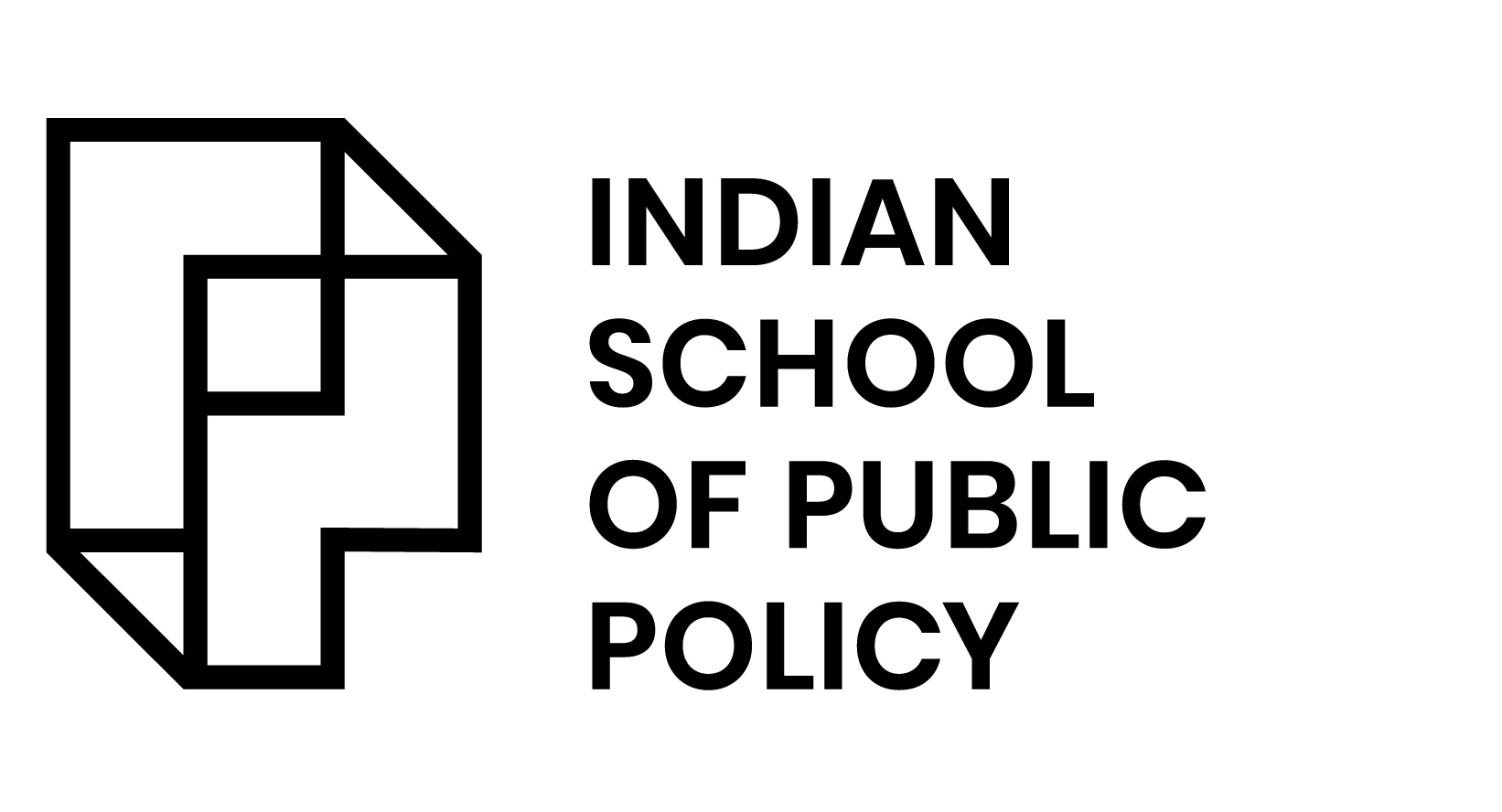
The Foreign Economic Policy of A Rising India

Liberalism is the trust of the people tempered by prudence. Conservatism is distrust of the people tempered by fear.
~William E. Gladstone
Preamble
The economic and strategic interests of a country are often inextricably intertwined. In the modern world, no country can ignore its economic interest and economic growth since they have a bearing on its strategic interest as well. Rapid changes in the world economy have been led by a revolution of sorts in technology and communication. As a result, “the world has become a smaller place” and the order of the day hinges on economic cooperation amongst nations. “Globalisation” is leading to a proactive association amongst nations as countries look to maximise economic gains.
Thus, it becomes necessary for every country to have a proactive foreign economic policy. As economic cooperation amongst countries increases, unified global progress also takes root.
Global engagement essentially has certain advantages:
- As nations become interdependent economically, hostile interactions tend to decrease in general and peace is likely to prevail.
- As countries develop resources, they access technologies and this has a multiplier effect on the economy as well.
- There is a positive effect on the developmental cycle, allowing nations, societies, regions, and sectors to develop.
“Globalisation” is leading to a proactive association amongst nations as countries look to maximise economic gains. Thus, it becomes necessary for every country to have a proactive foreign economic policy.
Foreign Economic Policy of India Post Independence – A Background
Post-independence, India started to follow a mixed economy model. This combined the features of capitalism and socialism. However, the policy had social leanings for obvious reasons. Industry and infrastructure were virtually nonexistent. The government had to intervene in business by walking a tightrope. The emphasis was on encouraging exports and controlling or substituting imports.
The liberalisation effort of 1991, was led by a balance of payments crisis that led to a severe recession. India’s efforts to secure loans from IMF and World Bank led to a precondition that it had to undertake structural adjustment programs.
Thus, India adopted a more liberal and free market policy and opened up its economy to the world in 1991. The government controls through licensing policies were also liberalised leading to a gradual opening up of sectors, industries, and countries. The EXIM policy of the Indian government was also tweaked and products on the open list went up while the restricted items came down. India also started to trade actively with countries on the SAARC and WTO blocks.
These reforms led to the Indian industry becoming competitive and growth was achieved and visible in sectors like auto parts, telecommunications, software exports, pharmaceuticals, and biotechnology. Foreign investment increased and Indian capital markets also matured to attract foreign investors. The over-reliance on agriculture started to come down and total goods and services trade to GDP almost doubled.
Post independence, industry and infrastructure were virtually non-existent. The government had to intervene in business by walking a tightrope. The emphasis was on encouraging exports and controlling or substituting imports.
Foreign Economic Policy of A Rising India
Fast forward to 2014 and now, and India has moved on from the non-aligned strategy followed earlier. Now we have a multi-aligned approach that looks at prioritising “India’s interests” to remain relevant and compete in a multi-polar world. India’s assertive approach has led to a boost in bilateral relations with key trading partners. India continues to build closer economic ties with countries like the US, Russia, and even China. However, that being said, it also is positioning itself as a leader of emerging economies at multilateral forums. The recognition of India’s economic prowess, stability, and potential is finally recognized as the world looks at a “China plus one” policy.
Years of good growth in the Indian economy have led to India attaining the status of the world’s fifth-largest economy. Undoubtedly India’s stock has risen and it is now being recognised. The key to India’s recognition on the world stage as an economic powerhouse is the government’s investment of time and energy in promoting India’s international relations and global image. India now sees itself as a global player, and not just a sub-continental mover and shaker.
Register your Interest to Study at ISPP
India, in recent times, has been looking to follow a policy of neoliberalism in its foreign economic policy. India is in favour and advocates free trade and no protectionism. It is looking to boost trade through free trade agreements (FTAs) and is in the process of signing FTAs with many countries. India has already negotiated or signed FTAs with more than 30 countries as of today. These interactions would create a web of economic interdependence, which in turn would lead to an era of greater mutual understanding and harmony.
Increased Chinese ascendancy in the region could and would loom as a major security and economic threat to India. This would result in a shift in geo-political equations and make life difficult for India with the security threats on the borders. To counter the dominance of China, India has to continue to grow at a fast clip and thereby hold its own.
With a growing population that has recently overtaken that of China, it is imperative to have a robust and capable foreign economic policy. It is given that Foreign Trade would be crucial for India’s economic development and could make a significant contribution to the economic welfare of the people. India by itself does not possess the adequate infrastructure and raw material resources for the production of goods and services that it consumes. While the concept of Make In India and Atmanirbhar Bharat is a long-term step aimed at India’s self-reliance, economies of scale and international specialisation could be derived through scientific and technological progress. This could only be achieved through foreign trade.
As India opens up further through trade liberalisation, it would fuel India’s economic growth and also contribute to its increasing influence abroad. At the end of the day, the larger target of becoming a 5-trillion-dollar economy is the silver lining on the horizon.
India has moved on from the non-aligned strategy followed earlier. The recognition of India’s economic prowess, stability, and potential is finally recognized as the world looks at a “China plus one” policy.
ISPP
The Indian School of Public Policy (ISPP), incubated by India’s leading public policy think tank – Centre for Civil Society (CCS) was established by the world’s leading experts, policy-makers, and influencers. ISPP has encouraged the youth to critically analyze, inquire, and comprehend the principles of sound policy, and continues to inspire young minds to promote and achieve social change through public policies.
With a year-long, Postgraduate Programme in Public Policy, Design & Management is ISPP’s flagship programme for postgraduates looking to make an impact in the public policy domain. The one-year course trains students by taking them through a rigorous programme divided into 7 terms of 7 weeks each. Additionally, ISPP PDM Programme offers various access to professional forums, career and placement support, and networking opportunities.
With a year-long, Postgraduate Programme in Public Policy, Design & Management is ISPP’s flagship programme for postgraduates looking to make an impact in the public policy domain.
FAQs
What is the significance of having a proactive foreign economic policy?
It becomes necessary for every country to have a proactive foreign economic policy. As economic cooperation amongst countries increases, unified global progress also takes root.
Global engagement essentially has certain advantages:
- As nations become interdependent economically, hostile interactions tend to decrease in general and peace is likely to prevail.
- As countries develop resources, they access technologies and this has a multiplier effect on the economy as well.
- There is a positive effect on the developmental cycle, allowing nations, societies, regions, and sectors to develop.
India has moved on from the non-aligned strategy followed earlier. The recognition of India’s economic prowess, stability, and potential is finally recognized as the world looks at a “China plus one” policy. Years of good growth in the Indian economy have led to India attaining the status of the world’s fifth-largest economy. Undoubtedly India’s stock has risen and it is now being recognised. The key to India’s recognition on the world stage as an economic powerhouse is the government’s investment of time and energy in promoting India’s international relations and global image. India now sees itself as a global player, and not just a sub-continental mover and shaker.
The Indian School of Public Policy (ISPP), incubated by India’s leading public policy think tank – Centre for Civil Society (CCS) was established by the world’s leading experts, policy-makers, and influencers. ISPP has encouraged the youth to critically analyze, inquire, and comprehend the principles of sound policy, and continues to inspire young minds to promote and achieve social change through public policies.
With a year-long, Postgraduate Programme in Public Policy, Design & Management is ISPP’s flagship programme for postgraduates looking to make an impact in the public policy domain. The one-year course trains students by taking them through a rigorous programme divided into 7 terms of 7 weeks each. Additionally, ISPP PDM Programme offers various access to professional forums, career and placement support, and networking opportunities.
Check Infographics



